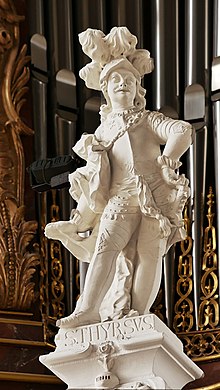
Pope Cornelius was the bishop of Rome from 6th or 13th March 251 until his martyrdom in June 253. He was pope during and following a period of persecution of the church, while a schism occurred over how repentant church members who had practiced pagan sacrifices to protect themselves could be readmitted to the church. He agreed with Cyprian of Carthage that those who had lapsed could be restored to communion after varying forms of Reinitiation and Penance. This position was in contrast to the Novatianists, who held that those who failed to maintain their confession of faith under persecution would not be received again into communion with the church. This resulted in a short-lived schism in the Church of Rome that spread as each side sought to gather support. Cornelius held a synod that confirmed his election and excommunicated Novatian, but the controversy regarding lapsed members continued for years.

Saint Christopher is venerated by several Christian denominations. According to these traditions, he was a martyr killed in the reign of the 3rd-century Roman emperor Decius, or alternatively under the emperor Maximinus Daia. Churches and monasteries were named after him by the 7th century. There is no evidence for the historicity of the saint.

Agathaof Sicily is a Christian saint. Her feast is on 5 February. Agatha was born in Catania, part of the Roman Province of Sicily, and was martyred c. 251. She is one of several virgin martyrs who are commemorated by name in the Canon of the Mass.

Vincent of Saragossa, the Protomartyr of Spain, was a deacon of the Church of Saragossa. He is the patron saint of Lisbon, Algarve, and Valencia. His feast day is 22 January in the Catholic Church, Anglican Communion, and the Eastern Orthodox Church, with an additional commemoration on 11 November in the Eastern Orthodox Church. He was born at Huesca and martyred under the Emperor Diocletian around the year 304.

Saint Acacius, also known as Agathius of Byzantium, Achatius, or Agathonas to Christian tradition, was a Cappadocian Greek centurion of the imperial army, martyred around 304. A church existed in Constantinople associated with Acacius and possibly named after him: the Church of St Acacius.

Sisteron is a commune in the Alpes-de-Haute-Provence department, Provence-Alpes-Côte d'Azur, southeastern France.

August 16 - Eastern Orthodox liturgical calendar - August 18

Saint Pantaleon, counted in Western Christianity as among the Fourteen Holy Helpers of the Late Middle Ages, and in Eastern Christianity as one of the Holy Unmercenary Healers, was a martyr of Nicomedia in Bithynia during the Diocletianic Persecution of 305 AD.
Callinicus or Kallinikos is a surname or male given name; the feminine form is Callinice or Callinica. It is of Greek origin, meaning "beautiful victor".
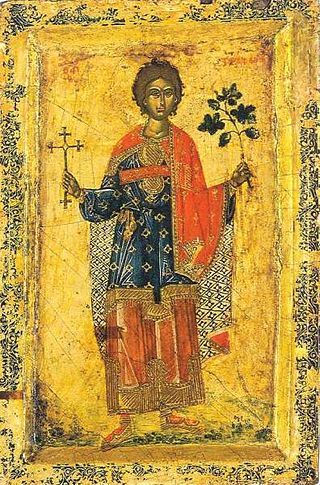
Saint Tryphon of Campsada was a 3rd-century Christian saint. He is venerated by the Roman Catholic and Eastern Orthodox churches as a great martyr and holy unmercenary.
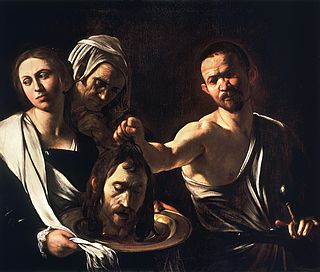
The beheading of John the Baptist, also known as the decollation of Saint John the Baptist or the beheading of the Forerunner, is a biblical event commemorated as a holy day by various Christian churches. According to the New Testament, Herod Antipas, ruler of Galilee under the Roman Empire, had imprisoned John the Baptist because he had publicly reproved Herod for divorcing his first wife and unlawfully taking his sister-in-law as his second wife Herodias. He then ordered him to be killed by beheading.

Pancras or Pancratius is an Italian saint associated with Taormina and venerated as a Christian martyr. His surviving hagiography is purely legendary. He is, however, recorded in some early martyrologies.
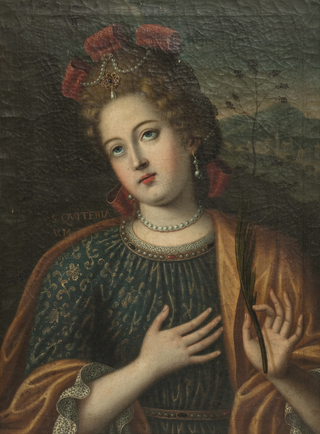
Quiteria was a second-century virgin martyr about whom little is certain except her name, the day and the place of her death, and her cult. She is listed under the date of 22 May in the Roman Martyrology. She is one of the patron saints of Toledo, Spain. Accounts of her life are "absolutely legendary".

Saints Victor and Corona are two Christian martyrs. Victor was a Roman soldier who was tortured and killed; Corona was killed for comforting him. Corona is invoked as a patron of causes involving money; she was not historically associated with pandemics or disease, but has been invoked against the coronavirus pandemic.

Justus of Beauvais is a semi-legendary saint of the Roman Catholic Church. He may have been a Gallo-Roman martyr, but his legend was confused with that of other saints, such as Justin of Paris.

In Christianity, the translation of relics is the ceremonial removal of holy objects from one place to another. Usually only the movement of the remains of a saint's body would be treated so formally, with secondary relics such as items of clothing treated with less ceremony. Translations could be accompanied by many acts, including all-night vigils and processions, often involving entire communities.

Severus of Barcelona is venerated as a saint by the Catholic and Eastern Orthodox churches. His legend states that he was a bishop of Barcelona and was martyred during the persecution of Christians by Diocletian in AD 304. Details concerning his life and death are uncertain and of questionable historicity.
A thyrsus is a staff of giant fennel covered with ivy vines and leaves.
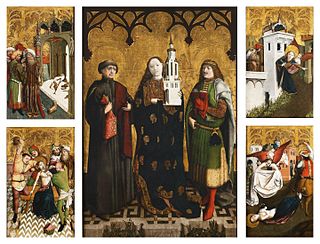
Saint Barbara, known in the Eastern Orthodox Church as the Great Martyr Barbara, was an early Christian Greek saint and martyr. There is no reference to her in the authentic early Christian writings nor in the original recension of Saint Jerome's martyrology.

December 13 – Eastern Orthodox liturgical calendar – December 15
